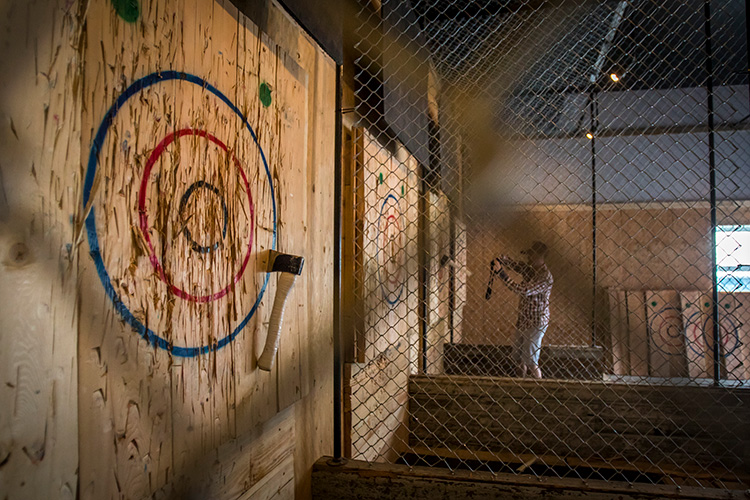Step Up Your Game with Axe Throwing Denver: Master Your Competencies Today
Step Up Your Game with Axe Throwing Denver: Master Your Competencies Today
Blog Article
The Fun of Axe Throwing: Exactly How This Sport Combines Skill and Adrenaline for a Good Time
Axe throwing has arised as a mesmerizing sport that masterfully links the demand for precise ability with the thrill of adrenaline, offering participants a unique and engaging experience. The act of tossing an axe in the direction of a target demands concentration and method, simultaneously promoting an ambience of camaraderie and friendly competition.
The Origins of Axe Throwing
Axe tossing, a leisure task that has actually acquired considerable appeal in current years, traces its roots back to old times. The earliest documents of axe use in affordable contexts are located amongst the Celts and Vikings, who tossed axes for sport as well as in battle training.
Medieval European warriors, particularly during the Center Ages, practiced axe tossing as part of their martial training. The Francisca, a kind of tossing axe used by the Franks, became famous for its deadly precision. This conventional tool was designed to be thrown at enemy shields and shield, showcasing its dual energy in both sport and fight.
In even more current history, axe tossing saw a revival in the logging camps of North America in the 19th and 20th centuries. Lumberjacks would involve in friendly competition, evaluating their accuracy and strength by targeting at wooden targets. This advancement from a survival ability to a recreational activity has actually led the means for its modern-day rebirth, with dedicated locations and organizations now commemorating the sporting activity internationally.
Equipment You Need
Recognizing the abundant history of axe tossing boosts the recognition of the sporting activity's modern model. For leisure and affordable axe throwing, the most frequently utilized type is the hatchet, normally considering between 1.25 to 2 pounds with a handle length of about 16 inches.
Equally crucial is the target. Policy targets are built from wood, with softwood ranges like yearn or cottonwood being preferred for their ability to hold the axe and take in. The target is typically divided into five concentric circles, each with a particular point value, to assist in scoring.
Safety gear, however typically neglected, is vital. Protective handwear covers can enhance grasp and avoid blisters, while closed-toed shoes are a should to safeguard feet from gone down axes (ax throwing denver). Finally, a well-lit, spacious throwing location, full with security barriers, ensures a regulated setting where individuals can concentrate on sharpening their skills.
Standard Techniques Described
Understanding the fundamental techniques of axe throwing is crucial for both security and efficiency. The leading hand must be positioned directly below the axe head, while the non-dominant hand sustains the end of the take care of.
Next, concentrate on the stance. Stand with your feet shoulder-width apart, ensuring your body is balanced. Your leading foot must be somewhat ahead, lining up with your target. This positioning aids in maintaining stability and directing power precisely in the direction of the target.

Safety First
Making certain safety and security click here for info in axe throwing is extremely important to creating a delightful and injury-free experience. Safety and security gauges start with the location layout. A well-designed axe tossing facility features clear demarcations in between throwing lanes, durable backdrops to capture roaming axes, and non-slip floor covering to avoid mishaps. Furthermore, adequate illumination is important to assist participants preserve aesthetic accuracy and spatial recognition.
Advantages of Axe Throwing
Axe throwing deals a myriad of benefits that expand past simple entertainment. The repetitive activity of tossing the axe additionally boosts hand-eye control and fine electric motor skills.
Emotionally, axe tossing calls for precision, emphasis, and approach, making it an excellent method to develop cognitive abilities. The concentration required to strike the target can act as a type of mindfulness, enabling individuals to remove their minds and lower anxiety. This psychological engagement can be specifically valuable in assisting people develop much better analytic abilities and psychological durability.
Socially, axe throwing is typically appreciated in group settings, fostering team-building and sociability. Whether as component of a business event or a casual trip with good friends, the sport motivates interaction and cooperation. Additionally, the common experience of learning and improving with each other can reinforce connections and produce enduring memories.
Conclusion

The earliest records of axe usage in affordable contexts are discovered among the Celts and Vikings, who threw axes for sporting activity as well as in fight training. Launch the axe when your hands are about at eye degree, permitting the axe's all-natural turning to guide it towards the target.
A properly designed axe tossing center features clear separations in between tossing lanes, durable their explanation backdrops to capture stray axes, and non-slip flooring to stop mishaps. Participants must be advised on the appropriate means to throw the axe and deal with, highlighting regulated, intentional motions over forceful throws.
In summary, axe throwing stands out as a sport that masterfully integrates ability, adrenaline, and precision.
Report this page